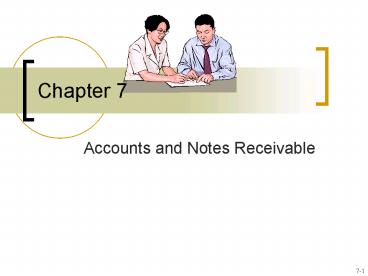Accounts and Notes Receivable - PowerPoint PPT Presentation
1 / 28
Title:
Accounts and Notes Receivable
Description:
Chapter 7 Accounts and Notes Receivable 7-* * Part One Now assume that Martin sends Barton a partial payment of two hundred dollars after Barton made the write-off entry. – PowerPoint PPT presentation
Number of Views:652
Avg rating:3.0/5.0
Title: Accounts and Notes Receivable
1
Chapter 7
- Accounts and Notes Receivable
7-1
2
Valuing Accounts Receivable
P1/P2
- Some customers may not pay their account.
Uncollectible amounts are referred to as bad
debts. There are two methods of accounting for
bad debts - Direct Write-Off Method
- Allowance Method
7-2
3
Direct Write-Off Method
P1
- On August 4, Barton determines it cannot
collect 350 from Martin, Inc., a credit customer.
7-3
4
Direct Write-Off Method
P1
- On September 9, Martin decides to pay 200
that was previously written off.
7-4
5
Matching vs. Materiality
P1
The Materiality Constraint states that an amount
can be ignored if its effect on the financial
statements is unimportant to users business
decisions.
The Matching Principle requires expenses to be
reported in the same accounting period as the
sales they help produce.
7-5
6
Allowance Method
P2
- At the end of each period, estimate total bad
debts expected to be realized from that periods
sales. - There are two advantages to the allowance method
- It records estimated bad debts expense in the
period when the related sales are recorded. - It reports accounts receivable on the balance
sheet at the estimated amount of cash to be
collected.
7-6
7
Estimating Bad Debts Expense
P2
- Two Methods
- Percent of Sales Method and
- Accounts Receivable Methods
- Percent of Accounts Receivable Method
- Aging of Accounts Receivable Method.
7-7
8
Percent of Accounts Receivable
P2
Barton has 100,000 in accounts receivable and a
900 credit balance in Allowance for Doubtful
Accounts on December 31, 2011. Past experience
suggests that 4 of receivables are
uncollectible. What is Bartons Bad Debts
Expense for 2011?
7-8
9
Percent of Accounts Receivable
P2
7-9
10
Aging of Accounts Receivable Method
P2
- Each receivable is grouped by how long it is
past its due date.
- Each age group is multiplied by its estimated
bad debts percentage.
- Estimated bad debts for each group are totaled.
7-10
11
Aging of Accounts Receivable
P2
7-11
12
Aging of Accounts Receivable
P2
Bartons unadjusted balance in the allowance
account is 900. We estimated the proper balance
to be 5,320.
7-12
13
Writing Off a Bad Debt
P2
- With the allowance method, when an account is
determined to be uncollectible, the debit goes to
Allowance for Doubtful Accounts.
Barton determines that Martins 300 account
is uncollectible.
7-13
14
Recovery of a Bad Debt
P2
- Subsequent collections on accounts written
off require that the original write-off entry be
reversed before the cash collection is recorded.
7-14
15
Percent of Sales Method
P2
Bad debts expense is computed as follows
Barton has credit sales of 1,400,000 in 2011.
Management estimates 0.5 of credit sales will
eventually prove uncollectible. What is Bad
Debts Expense for 2011?
7-15
16
Percent of Sales Method
P2
Bartons accountant computes estimated Bad Debts
Expense of 7,000.
7-16
17
Percent of Accounts Receivable Method
P2
- Compute the estimate of the Allowance for
Doubtful Accounts. - Bad Debts Expense is computed as
7-17
18
Summary
P2
Income Statement Focus
Balance Sheet Focus
Balance Sheet Focus
7-18
19
Notes Receivable
C2
1,000.00
July 10, 2011
Ninety days
after date I promise to pay to
Barton Company, Los Angeles, CA
the order of
One thousand and no/100 --------------------------
-------
Dollars
First National Bank of Los Angeles, CA
Payable at
12
Value received with interest at
per annum
Julia Browne Would be signed
42
Oct. 8, 2011
No. Due
7-19
20
Interest Computation
C2
7-20
21
Computing Maturity and Interest
C2
- On March 1, 2011, Matrix, Inc. purchased a
copier for 12,000 from Office Supplies, Inc.
with a 9 note due in 90 days. - What is the interest at maturity for this
note? (P x i x T) - What is the total amount due at maturity? (MV
i P) - What is the maturity date of the note?
7-21
22
Computing Maturity and Interest
C2
7-22
23
Computing Maturity Value
C2
7-23
24
Computing Maturity and Interest
C2
The note is due and payable on May 30, 2011.
Note was dated March 1st and is for 12,000 at 9
for 90 days.
7-24
25
Factoring Receivables Companies sometimes need
cash before customers pay their account balances.
In such situations, the company may choose to
sell accounts receivable to another company that
specializes in collections. This process is
called factoring, and the company that purchases
accounts receivable is often called a factor.
The factor usually charges between one and
fifteen percent of the account balances. The
reason for such a wide range in fees is that the
receivables may be factored with or without
recourse. Recourse means the company factoring
the receivables agrees to reimburse the factor
for uncollectible accounts. Low percentage rates
are usually offered only when recourse is
provided.
26
Disposing of Receivables
C3
- Companies sometimes want to convert receivables
to cash before they are due. - They can sell or factor receivables.
- They may pledge receivables as security for a
loan. - When we sell/factor our accounts receivable, we
debit FACTORING EXPENSE at the time we receive
the cash. - Factoring expense is typically a of our AR
7-26
27
Accounts Receivable Turnover
A1
- This ratio provides useful information for
evaluating how efficient management has been in
granting credit to produce revenue.
Accounts receivable turnover
Net sales
Average accounts receivable, net
7-27
28
End of Chapter 7
7-28































